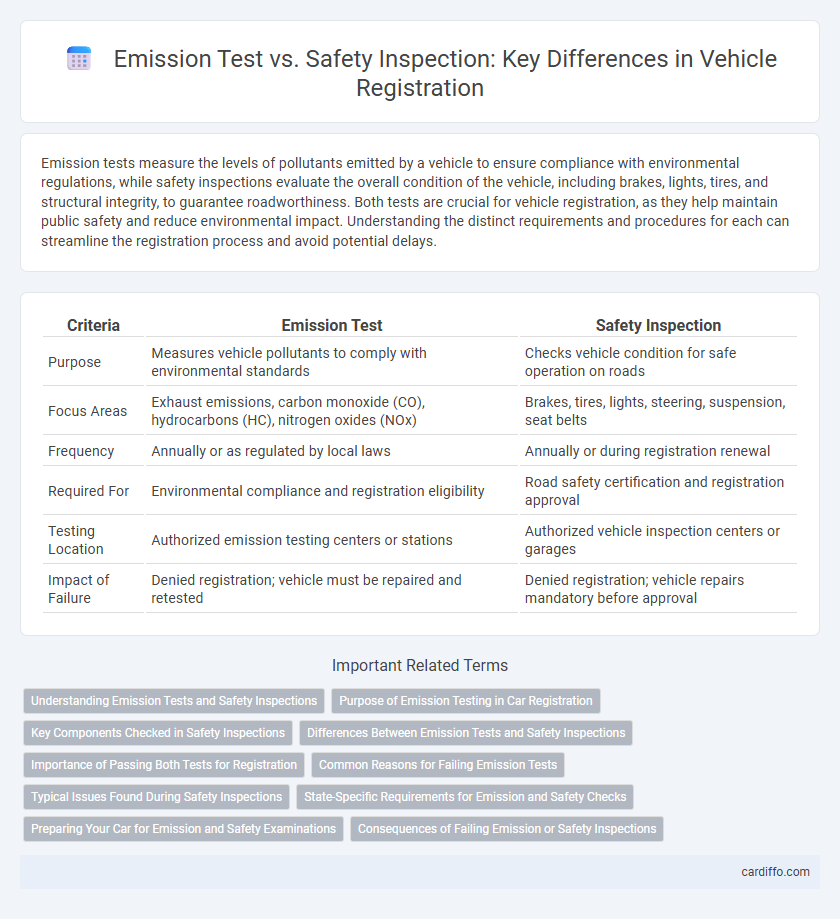Emission tests measure the levels of pollutants emitted by a vehicle to ensure compliance with environmental regulations, while safety inspections evaluate the overall condition of the vehicle, including brakes, lights, tires, and structural integrity, to guarantee roadworthiness. Both tests are crucial for vehicle registration, as they help maintain public safety and reduce environmental impact. Understanding the distinct requirements and procedures for each can streamline the registration process and avoid potential delays.
Table of Comparison
| Criteria | Emission Test | Safety Inspection |
|---|---|---|
| Purpose | Measures vehicle pollutants to comply with environmental standards | Checks vehicle condition for safe operation on roads |
| Focus Areas | Exhaust emissions, carbon monoxide (CO), hydrocarbons (HC), nitrogen oxides (NOx) | Brakes, tires, lights, steering, suspension, seat belts |
| Frequency | Annually or as regulated by local laws | Annually or during registration renewal |
| Required For | Environmental compliance and registration eligibility | Road safety certification and registration approval |
| Testing Location | Authorized emission testing centers or stations | Authorized vehicle inspection centers or garages |
| Impact of Failure | Denied registration; vehicle must be repaired and retested | Denied registration; vehicle repairs mandatory before approval |
Understanding Emission Tests and Safety Inspections
Emission tests measure the level of pollutants in a vehicle's exhaust to ensure compliance with environmental standards, thereby reducing air pollution. Safety inspections evaluate critical vehicle components such as brakes, lights, tires, and steering systems to confirm the car meets safety regulations. Both processes are essential for vehicle registration, ensuring environmental responsibility and road safety.
Purpose of Emission Testing in Car Registration
Emission testing ensures vehicles meet environmental standards by measuring pollutants such as carbon monoxide, nitrogen oxides, and hydrocarbons to reduce air pollution. This process verifies that the vehicle's engine and exhaust systems function properly to minimize harmful emissions. Meeting these requirements is essential for car registration approval, promoting cleaner air and public health.
Key Components Checked in Safety Inspections
Safety inspections primarily focus on key components such as brakes, tires, suspension, steering systems, lights, and seat belts to ensure vehicle safety standards are met. Emission tests, in contrast, evaluate the vehicle's exhaust system and pollutant output to comply with environmental regulations. Both inspections are critical for vehicle registration but target different aspects of car functionality and compliance.
Differences Between Emission Tests and Safety Inspections
Emission tests evaluate vehicle exhaust to measure pollutants like carbon monoxide and nitrogen oxides, ensuring compliance with environmental regulations. Safety inspections assess mechanical components such as brakes, lights, and tires to verify the vehicle's roadworthiness and overall safety. Both are mandatory for vehicle registration but target different aspects: emissions for environmental impact and safety inspections for operational integrity.
Importance of Passing Both Tests for Registration
Passing both the emission test and safety inspection is essential for vehicle registration compliance, ensuring environmental standards and roadworthiness. Emission tests verify that the vehicle meets air quality regulations by limiting harmful pollutants, while safety inspections confirm that key components like brakes, lights, and tires function properly to prevent accidents. Failure in either test can result in registration denial, highlighting the critical role these assessments play in promoting public health and safety.
Common Reasons for Failing Emission Tests
Common reasons for failing emission tests include a faulty oxygen sensor, a malfunctioning catalytic converter, and engine misfires that cause increased exhaust emissions. Excessive idling, using the wrong fuel type, and poor maintenance such as worn spark plugs or dirty air filters also contribute to higher pollutant levels. Addressing these issues before registration ensures compliance with environmental standards and avoids costly retests.
Typical Issues Found During Safety Inspections
Safety inspections typically identify issues such as worn brake pads, malfunctioning lights, and tire tread below the legal limit, which can compromise vehicle safety. Other common problems include faulty seat belts, broken windshield wipers, and exhaust leaks that may not be detected during emission tests. These defects highlight the importance of comprehensive safety inspections to ensure roadworthiness beyond emission standards.
State-Specific Requirements for Emission and Safety Checks
State-specific requirements for vehicle registration often mandate separate emission tests and safety inspections to ensure compliance with environmental and road safety standards. Emission tests vary by state, targeting pollutants like carbon monoxide and hydrocarbons, while safety inspections assess critical components such as brakes, lights, and tires for roadworthiness. Understanding local regulations helps vehicle owners prepare for mandatory checks and avoid registration delays or fines.
Preparing Your Car for Emission and Safety Examinations
Preparing your car for emission and safety examinations requires ensuring the engine is well-tuned and that all emission control systems are functioning properly to pass the emission test. Check critical safety components such as brakes, lights, tires, seatbelts, and windshield wipers to meet safety inspection standards. Regular maintenance and pre-inspection checks increase the likelihood of passing these registration requirements without delays or additional repairs.
Consequences of Failing Emission or Safety Inspections
Failing emission tests can result in fines, vehicle registration denial, and mandatory repairs to meet environmental standards. Safety inspection failures often lead to prohibitions on vehicle use, increased insurance premiums, and required fixes to address critical defects like brake or lighting issues. Timely compliance with both emission and safety inspections is essential to avoid legal penalties and ensure roadworthiness.
Emission Test vs Safety Inspection Infographic

 cardiffo.com
cardiffo.com